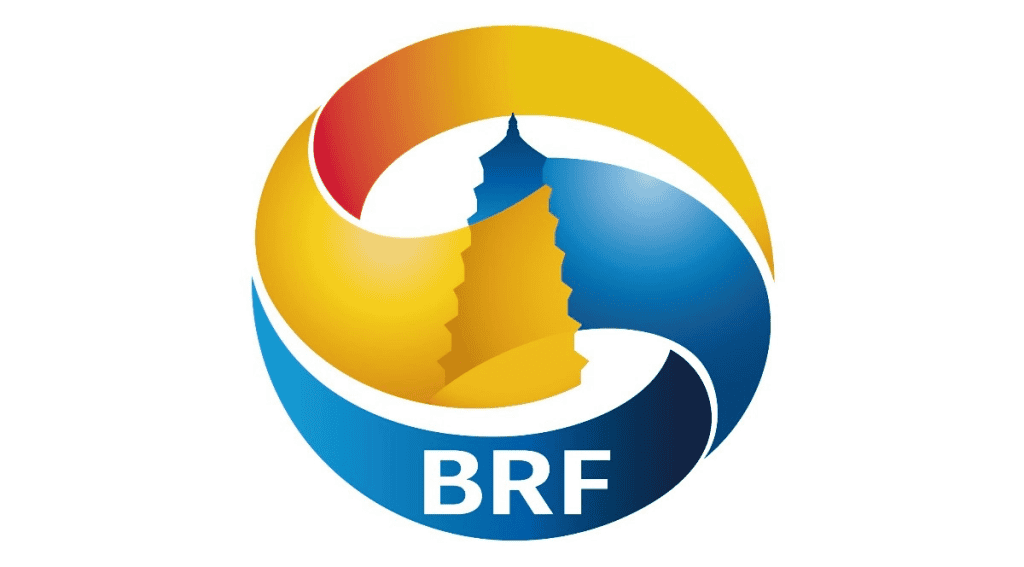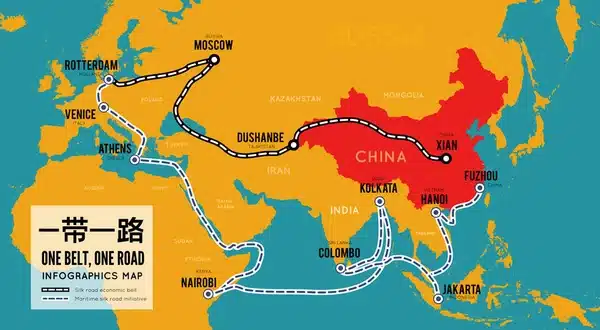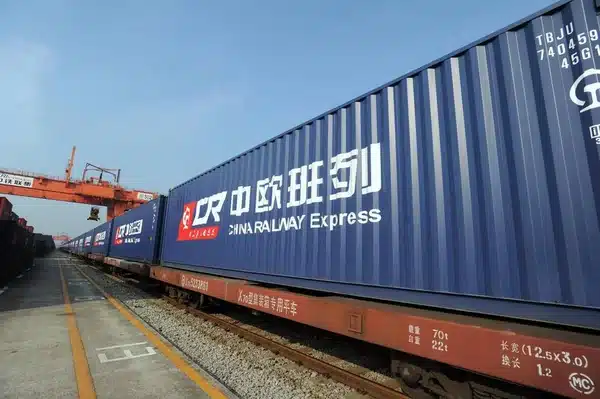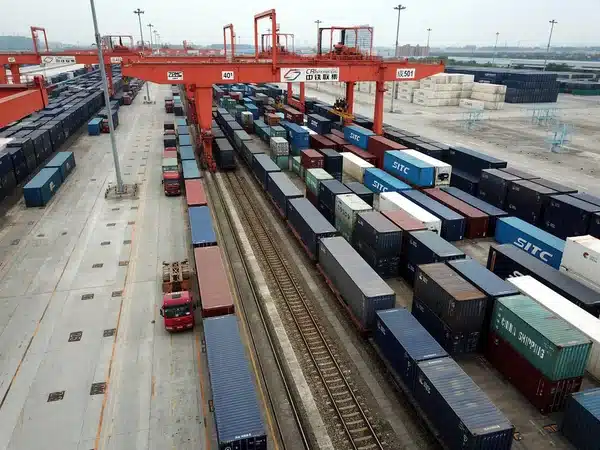The Belt and Road Initiative (BRI), launched by China in 2013, is one of the most ambitious infrastructure and economic development projects in history. Designed to improve global trade connectivity, the initiative spans more than 150 countries across Asia, Europe, Africa, and Latin America. Through the development of rail networks, highways, ports, and logistics hubs, the BRI is fundamentally reshaping global supply chains and freight forwarding operations.
For logistics companies, freight forwarders, and supply chain managers, the Belt and Road Initiative represents new opportunities and challenges in global trade. China-Europe rail freight, multimodal transport solutions, and infrastructure development in key trade corridors are driving faster, more cost-effective shipping options. As a result, businesses involved in e-commerce, manufacturing, and cross-border trade must adapt to these evolving logistics landscapes to stay competitive.
In this article, we explore how the BRI is transforming global logistics, the impact on freight forwarders, and the strategies needed to optimize shipping operations along new trade routes.

Table of Contents
Background of the Belt and Road Initiative and Its Impact on Global Trade
The Belt and Road Initiative (BRI) is a transformative economic strategy initiated by China in 2013. It aims to develop trade routes, infrastructure networks, and economic partnerships across multiple continents, fostering global trade expansion and logistics efficiency. The initiative primarily consists of two major components:
The Silk Road Economic Belt
A land-based trade corridor connecting China to Europe via Central Asia and the Middle East, relying on railway networks, highways, and cross-border economic hubs. This corridor has been instrumental in reducing transit times for cargo between China and European markets, enhancing trade efficiency.
The 21st Century Maritime Silk Road
A sea-based trade network linking China with Southeast Asia, South Asia, Africa, and Europe. It focuses on developing key ports, boosting intercontinental shipping capacity, and strengthening maritime trade routes. Several strategic port investments have been made in locations such as Piraeus (Greece), Gwadar (Pakistan), and Colombo (Sri Lanka), improving trade flows between Asia, Africa, and Europe.
BRI’s Impact on Global Trade
The Belt and Road Initiative has significantly reshaped global trade by facilitating faster, more cost-effective shipping and enhancing economic ties between nations. Key impacts include:
Enhanced Trade Routes & Logistics Connectivity
The China-Europe freight train network, upgraded port facilities, and multimodal logistics hubs have improved trade efficiency. Businesses benefit from shorter transit times, lower costs, and greater access to new markets.
Expansion of Global Trade Markets
China’s trade partnerships with over 150 countries have led to higher export and import volumes across industries like automotive, electronics, textiles, and industrial machinery. This trade expansion fosters stronger economic cooperation and investment opportunities along the BRI corridors.
Shortened Transit Times
- China-Europe rail freight has cut transit times from 40-50 days (via sea) to just 12-20 days.
- New highway and port developments along the BRI have reduced bottlenecks, ensuring faster delivery of goods.
- E-commerce and express logistics services benefit from these improved trade routes, allowing businesses to expand into international markets more efficiently.
Logistics Cost Reduction
- New port investments and railway expansions have improved efficiency, reducing overall freight costs.
- Lower customs clearance times at newly developed economic zones have enhanced cargo processing speed.
- Freight forwarders and logistics companies can offer cost-effective multimodal transport solutions, improving supply chain operations.
By modernizing global trade infrastructure and logistics, the Belt and Road Initiative is reshaping supply chain dynamics and creating long-term opportunities for businesses worldwide.

Impact of the Belt and Road Initiative on the Logistics Industry
The Belt and Road Initiative (BRI) is revolutionizing global logistics by expanding trade routes, modernizing infrastructure, and integrating multimodal transport systems. This transformation has led to shorter transit times, lower costs, and increased efficiency, benefiting freight forwarders, manufacturers, and international traders.
The Rise of China-Europe Railway Freight Services
One of the most significant logistics innovations under the BRI is the China-Europe freight train network, which has become a game-changer in international shipping.
Why China-Europe Rail Freight Matters
- Faster than sea freight: Transit times of 12-24 days compared to 30-45 days by sea.
- Cheaper than air freight: Costs are significantly lower than air cargo, making rail a cost-effective alternative for high-value goods.
- Ideal for bulk shipments: Electronics, automobile parts, textiles, machinery, and e-commerce goods benefit the most.
Key China-Europe Rail Freight Routes & Transit Times
| Route | Major Cities Covered | Transit Time |
|---|---|---|
| Chongqing – Duisburg (Germany) | Xi’an, Warsaw (Poland), Malaszewicze | 12 – 16 days |
| Chengdu – Lodz (Poland) | Khorgos, Moscow, Minsk | 14 – 18 days |
| Xi’an – Madrid (Spain) | Kazakhstan, Moscow, Duisburg | 18 – 21 days |
| Zhengzhou – Hamburg (Germany) | Warsaw, Berlin | 15 – 19 days |
| Suzhou – Milan (Italy) | Duisburg, Lyon (France) | 20 – 24 days |
💡 For businesses looking to optimize supply chains, China-Europe rail freight offers a reliable, cost-effective solution for time-sensitive shipments.
Development of Multimodal Transport Solutions
The BRI encourages multimodal logistics, integrating rail, sea, and road transport to create seamless trade corridors.
Rail-Sea Transport: Faster & Cost-Effective
- Cargo transported via China-Europe rail can be offloaded at European ports (Hamburg, Rotterdam, Antwerp) and further shipped to Scandinavia, the UK, and North America.
- This hybrid approach reduces shipping costs and transit times for businesses relying on maritime trade.
Road-Rail Integration: Better Last-Mile Delivery
- Kazakhstan, Russia, and Belarus serve as key logistics hubs, where cargo is transferred between trains and trucks for final delivery.
- This integration enhances regional connectivity and delivery efficiency.
Port Development: Strengthening Global Trade
- Investments in Gwadar (Pakistan), Piraeus (Greece), and Colombo (Sri Lanka) improve sea-road connectivity.
- These ports act as key transit points for Asian, Middle Eastern, and European markets, making global trade more efficient.
💡 Multimodal transport reduces logistics bottlenecks, offering businesses flexible and cost-effective shipping options.
Infrastructure Development in BRI Countries
A major outcome of the Belt and Road Initiative is the massive investment in logistics infrastructure across Asia, Africa, Europe, and the Middle East.
Port Upgrades: Boosting Maritime Trade
- Gwadar (Pakistan): A critical port connecting China to the Arabian Sea and Middle East trade routes.
- Colombo (Sri Lanka): A major transshipment hub for cargo heading to South Asia, the Middle East, and Africa.
- Mombasa (Kenya): Expanded port capacity to handle increased trade with China and East Africa.
Railway Expansion: Improving Cargo Transit
- Kazakhstan, Russia, Poland, and Germany have invested in railway infrastructure, increasing train frequency and capacity.
- New railway links between China and Europe help move cargo faster and more efficiently.
Logistics Parks & Dry Ports: Strengthening Trade Corridors
- Hungary, Belarus, and Poland have developed dry ports to improve cargo handling efficiency.
- New distribution centers in Central Asia and Europe help process China-Europe rail shipments faster.
💡 By investing in ports, railways, and logistics hubs, the BRI is transforming trade infrastructure, making global logistics more efficient and interconnected.

Opportunities for Freight Forwarders in the BRI Era
The Belt and Road Initiative (BRI) is transforming global trade, offering freight forwarders significant opportunities to expand operations, reduce costs, and cater to diverse client needs. By leveraging new trade routes, infrastructure investments, and multimodal transport solutions, logistics providers can increase efficiency and improve global supply chain networks.
Expanding into New Markets
Freight forwarders are now able to tap into emerging markets that were previously difficult to access due to limited trade connectivity and underdeveloped infrastructure. The BRI has opened up new trade corridors, strengthening logistics operations in the following regions:
Central Asia: A Growing Transit Hub
Countries like Kazakhstan, Uzbekistan, and Turkmenistan are witnessing increased trade activity due to:
- China-Europe rail freight routes passing through Central Asia.
- Improved border clearance procedures and customs efficiency.
- Growing demand for logistics services in industrial and energy sectors.
Eastern Europe: A Logistics Gateway to the EU
Key countries such as Poland, Hungary, and Belarus are becoming major logistics hubs for Chinese exports to Europe, offering:
- Strategic locations for warehouse and distribution centers.
- Integration with EU transport networks, providing access to Western Europe.
- Opportunities for rail freight consolidation, reducing logistics costs.
Middle East & Africa: Strengthening Trade Links
- Investment in ports like Gwadar (Pakistan) and Mombasa (Kenya) is improving maritime trade efficiency.
- New railway and road networks are enabling faster cargo movement between China, the Middle East, and Africa.
- BRI-driven infrastructure projects are creating a demand for freight forwarding services to support trade growth in these regions.
💡 By establishing strong logistics operations in these emerging markets, freight forwarders can capture new business opportunities and expand their global reach.
Lowering Logistics Costs
The BRI is optimizing global supply chains, helping freight forwarders and shippers reduce logistics costs while maintaining efficiency.
Rail Freight: A Cost-Effective Alternative to Air and Sea Freight
- Rail freight is up to 40% cheaper than air freight and significantly faster than sea freight.
- Faster transit times (12-24 days) allow businesses to optimize inventory management without relying on expensive air cargo.
- Competitive rail rates encourage bulk shipments for electronics, automotive parts, textiles, and e-commerce goods.
Government Incentives in BRI Countries
Many BRI countries offer tax breaks, subsidies, and lower tariffs to encourage logistics investments, leading to:
- Lower operating costs for freight forwarders expanding into new markets.
- Reduced customs duties on key trade routes, improving pricing for clients.
- Financial incentives for developing regional distribution hubs.
Improved Port & Customs Efficiency
- Modernized customs clearance systems in major ports and railway hubs reduce bottlenecks.
- Enhanced digital tracking and documentation systems improve supply chain visibility.
- Lower warehousing costs due to faster cargo processing and reduced delays.
💡 Freight forwarders who leverage these cost-saving strategies can offer more competitive pricing and improve overall supply chain efficiency.
Diversification of Client Needs
As global supply chains become more complex, freight forwarders must adapt to evolving customer demands by offering integrated logistics solutions.
Multimodal Transport Solutions
- Integrating rail, sea, and road freight for seamless logistics operations.
- Providing flexible shipping options based on client preferences for cost, speed, and reliability.
- Handling cross-border logistics through new BRI trade corridors.
End-to-End Supply Chain Management
- Customs clearance, warehousing, and last-mile delivery services to support global trade.
- Logistics consulting and freight optimization services to help businesses streamline operations.
- Cold chain logistics solutions for perishables and pharmaceuticals.
E-Commerce Logistics & Express Freight
- China-Europe rail freight is becoming a vital channel for cross-border e-commerce.
- Freight forwarders can develop direct-to-consumer shipping solutions, reducing delivery times for online retailers.
- Express rail services offer a middle-ground option between expensive air freight and slow sea freight.
💡 By offering diversified logistics solutions, freight forwarders can attract more clients, optimize global trade routes, and gain a competitive advantage in the evolving BRI landscape.
Challenges and Solutions in BRI Logistics
While the Belt and Road Initiative (BRI) presents vast opportunities for global trade, freight forwarders and logistics providers face several challenges in optimizing operations across diverse regions. Navigating customs complexities, improving network efficiency, and selecting optimal transport modes are critical to success. Below are the key challenges and strategic solutions for logistics professionals operating within the BRI framework.
Customs Duties & Clearance Issues
Challenge: Complex and Inconsistent Customs Regulations
- Each BRI country has different import/export rules, tariffs, and clearance requirements, leading to delays and increased shipping costs.
- Limited digital integration between customs authorities can result in lengthy paperwork and manual processing.
- Customs duties, taxes, and tariff structures vary, making it difficult for businesses to predict final costs.
Solution: Streamlining Clearance with Digital and Localized Support
- Partner with experienced customs brokers in each region to ensure smooth clearance.
- Implement pre-clearance electronic data exchange (EDI) systems to submit customs documents in advance, reducing hold-ups at border crossings.
- Use bonded warehouses and Free Trade Zones (FTZs) along major BRI corridors to defer duties and taxes until goods are distributed.
- Utilize China’s Single Window System for trade compliance, which integrates customs clearance data with other regulatory bodies.
💡 By adopting digital customs solutions and local expertise, freight forwarders can significantly reduce delays and ensure seamless trade flow.
Optimizing Logistics Networks in BRI Regions
Challenge: Uneven Infrastructure Quality
- While China, Europe, and parts of Central Asia have well-developed transport networks, some BRI regions suffer from inadequate rail, road, and port infrastructure.
- Bottlenecks at border crossings and congested ports lead to inefficient cargo movement and increased transit times.
- Limited connectivity between multimodal hubs makes freight consolidation and distribution difficult.
Solution: Using Hub-and-Spoke Logistics Models & Smart Logistics Parks
- Adopt a hub-and-spoke distribution model, with key logistics hubs in China (Xi’an, Chengdu, Chongqing), Central Asia (Almaty, Tashkent), and Europe (Duisburg, Warsaw, Budapest).
- Leverage dry ports and inland container depots (ICDs) to distribute goods efficiently across regions.
- Invest in smart logistics parks near major transport corridors, incorporating real-time tracking, automated sorting, and AI-driven inventory management.
- Utilize transshipment hubs such as Piraeus (Greece), Gwadar (Pakistan), and Duisburg (Germany) for efficient cargo relay.
💡 By optimizing logistics hubs and smart technologies, freight forwarders can enhance efficiency and reduce costs across the BRI network.
Choosing the Best Transport Mode for BRI Shipments
Challenge: Balancing Cost, Speed, and Reliability
- Rail freight is faster than sea transport but can be costly, especially for long-haul routes.
- Sea freight is the most economical but has longer transit times, particularly during peak seasons.
- Air freight is the fastest but often too expensive for bulk cargo.
- The lack of real-time rate transparency and standardized pricing complicates decision-making.
Solution: Using Freight Cost Calculators & Route Optimization Software
- Implement AI-driven route optimization software to analyze cost, transit time, and cargo type to select the best transport mode.
- Use a combination of rail-sea-air freight to optimize costs and speed.
- Example: Ship from China to Europe via rail, then distribute within Europe by road.
- Example: Use sea freight from China to the Middle East, then air freight for urgent deliveries.
- Leverage dynamic pricing tools and digital freight marketplaces to secure the best rates.
- Adopt blockchain-based smart contracts to streamline freight agreements and ensure pricing transparency.
💡 With advanced logistics planning tools, freight forwarders can optimize transport routes, reduce costs, and improve reliability.
Case Study: Successful Use of the BRI in Freight Forwarding
Using China-Europe Rail Freight for E-Commerce Exports
Company Profile
A leading Chinese electronics manufacturer exporting high-demand consumer electronics and accessories to European retailers and e-commerce platforms.
Challenge: Overcoming Long Transit Times & High Air Freight Costs
- The company relied heavily on sea freight, which took over 35 days to reach European distribution centers.
- Air freight was too expensive for bulk shipments, reducing profit margins.
- Stock shortages in European markets caused delays in order fulfillment, affecting customer satisfaction.
Solution: Shifting to China-Europe Rail Freight
- The company switched to the Xi’an-Duisburg China-Europe rail freight corridor, leveraging the BRI’s growing rail infrastructure.
- Integrated a multimodal logistics approach, using rail freight for the main leg and trucks for final delivery across Europe.
- Partnered with a freight forwarder specializing in China-Europe rail logistics to streamline operations and ensure customs compliance.
Outcome: Faster, Cost-Effective Logistics
1. Transit time reduced by 50%
- Rail freight reduced transit time from 35+ days (sea freight) to just 16 days, ensuring faster inventory replenishment for European retailers.
2. 30% Cost Savings vs. Air Freight
- Rail freight was 30% cheaper than air freight, making it a cost-efficient alternative while maintaining fast delivery speeds.
3. Improved Inventory Turnover & Customer Satisfaction
- Better stock availability in European markets helped maintain sales momentum and improved supply chain efficiency.
- Retailers received products faster, reducing stockouts and increasing customer satisfaction.
Key Takeaways for Freight Forwarders
💡 China-Europe rail freight is an ideal solution for e-commerce exports—balancing speed, cost, and reliability.
💡 Multimodal shipping (rail + truck) ensures seamless last-mile delivery across European markets.
💡 E-commerce brands looking to expand in Europe should consider rail freight as a cost-efficient alternative to air freight and a faster option than sea shipping.
Expanding BRI Logistics for Global Trade
The Belt and Road Initiative continues to reshape global freight forwarding, offering businesses:
- Faster China-Europe trade lanes through expanded rail networks.
- More efficient multimodal logistics solutions, combining rail, sea, and air.
- Greater access to emerging markets across Europe, Central Asia, and the Middle East.
For businesses and logistics providers seeking cost-effective, time-sensitive, and reliable shipping solutions, China-Europe rail freight under the BRI provides a strategic advantage.

Conclusion: Long-Term Impact of the BRI on Freight Forwarding
The Belt and Road Initiative (BRI) is reshaping global trade logistics, opening up new opportunities for freight forwarders by streamlining transport networks, reducing shipping costs, and expanding access to emerging markets across Asia, Europe, Africa, and the Middle East. As more infrastructure projects are completed and multimodal transport systems improve, freight forwarding companies that adapt to these changes will gain a competitive edge in global trade.
Key Takeaways for Freight Forwarders:
✅ Leverage China-Europe Rail Freight
- The expansion of China-Europe rail freight corridors offers a balance between cost and speed, making it a viable alternative to traditional sea and air freight.
- Freight forwarders should promote rail solutions to e-commerce businesses, automotive manufacturers, and high-value cargo shippers seeking faster, cost-effective logistics.
✅ Expand into BRI Markets
- Central Asia, Eastern Europe, and Africa are rapidly growing logistics hubs due to increased trade connectivity under the BRI.
- Forwarders can capitalize on rising demand for logistics services in these markets by establishing partnerships with local transport providers and offering customs brokerage services.
✅ Offer Multimodal Logistics Solutions
- Integrating rail, sea, road, and air freight helps businesses optimize transit times, costs, and delivery flexibility.
- Freight forwarders should focus on developing multimodal shipping strategies that cater to varying customer needs.
✅ Invest in Digital Tracking & Customs Clearance Solutions
- AI-powered logistics tracking, blockchain for smart contracts, and automated customs clearance can improve supply chain efficiency.
- Digital tools reduce paperwork, improve cargo visibility, and accelerate border clearance, ensuring seamless trade flow across BRI routes.
Seize the Opportunities of the Belt and Road Initiative
The future of global trade is being shaped by the BRI’s extensive transport network, infrastructure investments, and logistics innovations. Freight forwarders who embrace digitalization, optimize BRI trade routes, and expand into high-growth markets will solidify their role as key logistics partners in international supply chains.
📦 Looking for expert freight forwarding solutions along BRI trade routes? 🚢🚆
Contact Tonlexing todayfor customized logistics solutions to move your cargo efficiently across the Belt and Road network!


